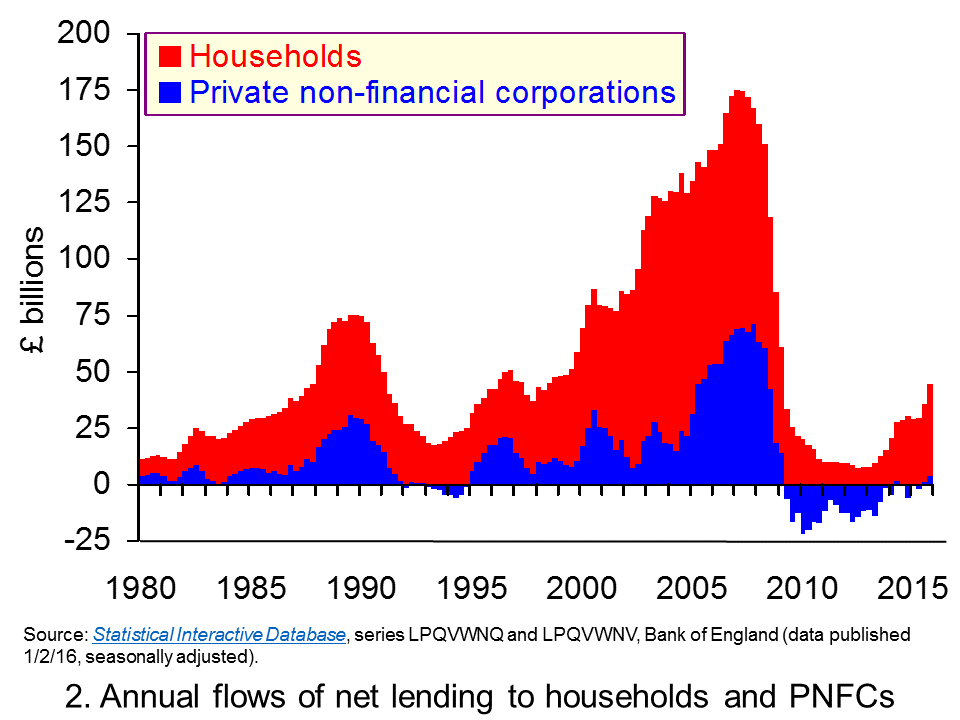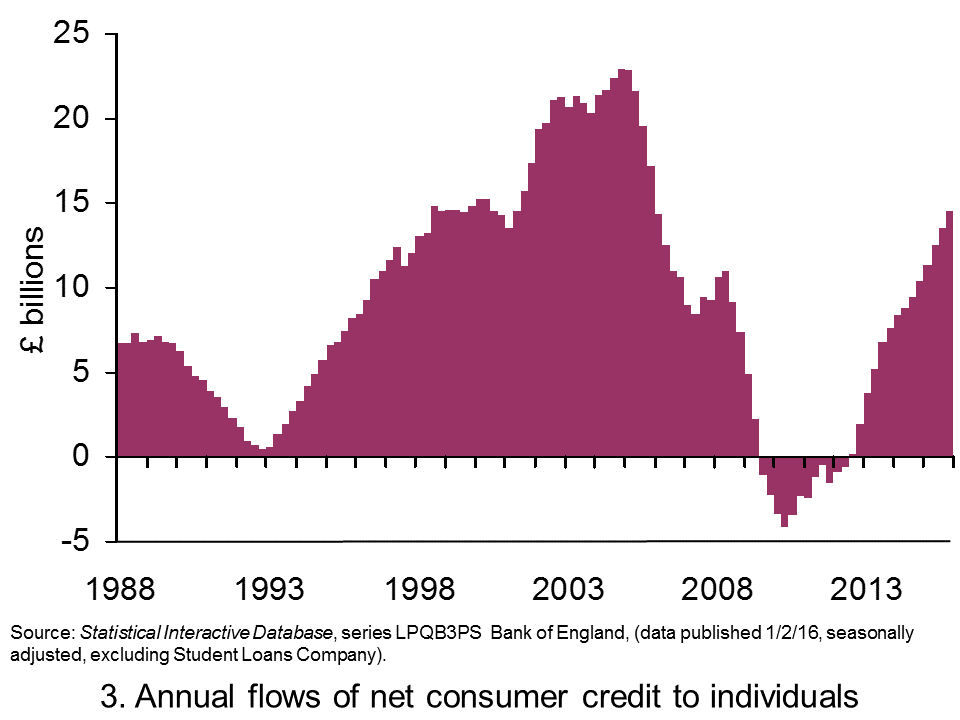 In an attempt to prevent recession following the financial crisis of 2007–8, many countries adopted both expansionary monetary policy and expansionary fiscal policy – and with some success. It is likely that the recession would have been much deeper without such policies
In an attempt to prevent recession following the financial crisis of 2007–8, many countries adopted both expansionary monetary policy and expansionary fiscal policy – and with some success. It is likely that the recession would have been much deeper without such policies
But with growing public-sector deficits caused by the higher government expenditure and sluggish growth in tax receipts, many governments soon abandoned expansionary fiscal policy and relied on a mix of loose monetary policy (with ultra low interest rates and quantitative easing) but tight fiscal policy in an attempt to claw down the deficits.
But such ‘austerity’ policies made it much harder for loose monetary policy to boost aggregate demand. The problem was made worse by the attempt of both banks and individuals to ‘repair’ their balance sheets. In other words banks became more cautious about lending, seeking to build up reserves; and many individuals sought to reduce their debts by cutting down on spending. Both consumer spending and investment were slow to grow.
And yet government and central banks, despite the arguments of Keynesians, were reluctant to abandon their reliance solely on monetary policy as a means of boosting aggregate demand. But gradually, influential international institutions, such as the IMF (see also) and World Bank, have been arguing for an easing of austerity fiscal policies.
 The latest international institution to take a distinctly more Keynesian stance has been the Organisation for Economic Co-operation and Development (OECD). In its November 2015 Economic Outlook it had advocated some use of public-sector investment (see What to do about slowing global growth?. But in its Interim Economic Outlook of February 2016, it goes much further. It argues that urgent action is needed to boost economic growth and that this should include co-ordinated fiscal policy. In introducing the report, Catherine L Mann, the OECD’s Chief Economist stated that:
The latest international institution to take a distinctly more Keynesian stance has been the Organisation for Economic Co-operation and Development (OECD). In its November 2015 Economic Outlook it had advocated some use of public-sector investment (see What to do about slowing global growth?. But in its Interim Economic Outlook of February 2016, it goes much further. It argues that urgent action is needed to boost economic growth and that this should include co-ordinated fiscal policy. In introducing the report, Catherine L Mann, the OECD’s Chief Economist stated that:
“Across the board there are lower interest rates, except for the United States. It allows the authorities to undertake a fiscal action at very very low cost. So we did an exercise of what this fiscal action might look like and how it can contribute to global growth, but also maintain fiscal sustainability, because this is an essential ingredient in the longer term as well.
 So we did an experiment of a two-year increase in public investment of half a percentage point of GDP per annum undertaken by all OECD countries. This is an important feature: it’s everybody doing it together – it’s a collective action, because it’s global growth that is at risk here – our downgrades [in growth forecasts] were across the board – they were not just centred on a couple of countries.
So we did an experiment of a two-year increase in public investment of half a percentage point of GDP per annum undertaken by all OECD countries. This is an important feature: it’s everybody doing it together – it’s a collective action, because it’s global growth that is at risk here – our downgrades [in growth forecasts] were across the board – they were not just centred on a couple of countries.
So what is the effect on GDP of a collective fiscal action of a half a percentage point of GDP [increase] in public investment in [high] quality projects. In the United States, the euro area, Canada and the UK, who are all contributors to this exercise, the increase in GDP is greater than the half percentage point [increase] in public expenditure that was undertaken. Even if other countries don’t undertake any fiscal expansion, they still get substantial increases in their growth rates…
Debt to GDP in fact falls. This is because the GDP effect of quality fiscal stimulus is significant enough to raise GDP (the denominator in the debt to GDP ratio), so that the overall fiscal sustainability [debt to GDP] improves.”
What is being argued is that co-ordinated fiscal policy targeted on high quality infrastructure spending will have a multiplier effect on GDP. What is more, the faster growth in GDP should outstrip the growth in government expenditure, thereby allowing debt/GDP ratios to fall, not rise.
This is a traditional Keynesian approach to tackling sluggish growth, but accompanied by a call for structural reforms to reduce inefficiency and waste and improve the supply-side of the economy.
Articles
Osborne urged to spend more on infrastructure by OECD Independent, Ben Chu (18/2/16)
OECD blasts reform fatigue, downgrades growth and calls for more rate cuts Financial Review (Australia), Jacob Greber (18/2/16)
OECD calls for less austerity and more public investment The Guardian, Larry Elliott (18/2/15)
What’s holding back the world economy? The Guardian, Joseph Stiglitz and Hamid Rashid (8/2/16)
OECD calls for urgent action to combat flagging growth Financial Times, Emily Cadman (18/2/16)
Central bankers on the defensive as weird policy becomes even weirder The Guardian, Larry Elliott (21/2/16)
Keynes helped us through the crisis – but he’s still out of favour The Guardian, Larry Elliott (7/2/16)
G20 communique says monetary policy alone cannot bring balanced growth
Reuters (27/2/15)
OECD publications
 Global Economic Outlook and Interim Economic Outlook OECD, Catherine L Mann (18/2/16)
Global Economic Outlook and Interim Economic Outlook OECD, Catherine L Mann (18/2/16)
Interim Economic Outlook OECD (18/2/16)
Questions
- Draw an AD/AS diagram to illustrate the effect of a successful programme of public-sector infrastructure projects on GDP and prices.
- Draw a Keynesian 45° line diagram to illustrate the effect of a successful programme of public-sector infrastructure projects on actual and potential GDP.
- Why might an individual country benefit more from a co-ordinated expansionary fiscal policy of all OECD countries rather than being the only country to pursue such a policy?
- What determines the size of the multiplier effect of such policies?
- How might a new classical/neoliberal economist respond to the OECD’s recommendation?
- Why may monetary policy have ‘run out of steam’? Are there further monetary policy measures that could be adopted?
- Compare the relative effectiveness of increased government investment in infrastructure and tax cuts as alterative forms of expansionary fiscal policy.
- Should quantitative easing be directed at financing public-sector infrastructure projects? What are the benefits and problems of such a policy? (See the blog post People’s quantitative easing.)
 The perceived wisdom is that nominal interest rates have a lower zero bound. The Swedish central bank (the Ricksbank) has effectively been charging financial institutions to deposit money at the central bank since 2009. On 29 January 2016 the Central Bank of Japan also introduced a negative interest rate on deposits. The -0.1 per cent rate currently applies to a portion of the reserves held by financial institutions at the central bank. The move is another attempt to pump energy into a struggling economy.
The perceived wisdom is that nominal interest rates have a lower zero bound. The Swedish central bank (the Ricksbank) has effectively been charging financial institutions to deposit money at the central bank since 2009. On 29 January 2016 the Central Bank of Japan also introduced a negative interest rate on deposits. The -0.1 per cent rate currently applies to a portion of the reserves held by financial institutions at the central bank. The move is another attempt to pump energy into a struggling economy.
 As the chart shows, since the mid 1990s there have been protracted periods of Japanese price deflation. In January 2013 Japan introduced a 2 per cent CPI inflation target. This was accompanied by a massive expansion of its quantitative easing programme, principally through purchases of government bonds from investors. Following the monetary loosening, buoyed too by a loosening of fiscal policy, the rate of inflation rose. It reached 3.7 per cent in May 2014.
As the chart shows, since the mid 1990s there have been protracted periods of Japanese price deflation. In January 2013 Japan introduced a 2 per cent CPI inflation target. This was accompanied by a massive expansion of its quantitative easing programme, principally through purchases of government bonds from investors. Following the monetary loosening, buoyed too by a loosening of fiscal policy, the rate of inflation rose. It reached 3.7 per cent in May 2014.
However, through 2015 the rate of inflation began to fall sharply, partly the result of falling commodity prices, especially oil. Now there appears to be an increasing fear at the Bank of Japan that deflation may be set to return. The introduction of a negative deposit rate is intended to prevent deflation. In particular by affecting expectations of inflation. The hope is to prevent a deflationary mindset becoming re-established.
 The further loosening of monetary policy through a negative interest rate follows on the heels of an acceleration of quantitative easing last October. Back then, the Bank of Japan said that it would conduct Open Market Operations so that the monetary base would increase annually be ¥80 trillion. This was reaffirmed in its 29 January announcement. For an economy that has experienced four recessionary contractions since 2008 and with provisional estimates suggesting that it contracted by 0.4 per cent in the final quarter of 2015, it remains to be seen whether further monetary loosening might yet be called for.
The further loosening of monetary policy through a negative interest rate follows on the heels of an acceleration of quantitative easing last October. Back then, the Bank of Japan said that it would conduct Open Market Operations so that the monetary base would increase annually be ¥80 trillion. This was reaffirmed in its 29 January announcement. For an economy that has experienced four recessionary contractions since 2008 and with provisional estimates suggesting that it contracted by 0.4 per cent in the final quarter of 2015, it remains to be seen whether further monetary loosening might yet be called for.
Data
Consumer Price Index Statistics Bureau of Japan
Articles
Bank of Japan adopts negative interest rate policy CNBC, Nyshka Chandran (29/1/16)
Japan adopts negative interest rate in surprise move BBC News (29/1/16)
Bank of Japan shocks markets by adopting negative interest rates Guardian, Justin McCurry (29/1/16)
Japan stuns markets by slashing interests rates into negative territory Telegraph, Mehreen Khan (29/1/16)
Japan introduces negative interest rate to boost economy The Herald, (29/1/16)
Questions
- What does a negative interest rate on deposits mean for depositors?
- What effect is the Bank of Japan hoping that a negative deposit rate will have on the Japanese economy? How would such effects be expected to occur?
- What effect might the Bank of Japan’s actions be expected to have on the structure of interest rates in the economy?
- How might the negative interest rate effect how people wish to hold their wealth?
- What are the dangers of deflation? Why is the Bank of Japan keen to avoid expectations of deflation becoming re-established?
- To what extent are national policy-makers able to exert pressure over the rate of inflation?
 The Bank of England’s Money and Credit release on 1 Feb provides us with data up to the end of 2015 on lending by banks and building societies to the rest of the UK private sector. In this post we update our blog of 17 December 2015 – is Minsky right yet again? – to analyse the latest data on lending. The headline numbers show that the flow of lending (net of repayments) by banks and building societies to UK households in 2015 was £40.8 billion up from £29.9 billion in 2014 taking their amount of outstanding lending to households to £1.26 trillion. Was American economist Minsky (1919-1996) right to have argued that cycles in credit are inevitable?
The Bank of England’s Money and Credit release on 1 Feb provides us with data up to the end of 2015 on lending by banks and building societies to the rest of the UK private sector. In this post we update our blog of 17 December 2015 – is Minsky right yet again? – to analyse the latest data on lending. The headline numbers show that the flow of lending (net of repayments) by banks and building societies to UK households in 2015 was £40.8 billion up from £29.9 billion in 2014 taking their amount of outstanding lending to households to £1.26 trillion. Was American economist Minsky (1919-1996) right to have argued that cycles in credit are inevitable?
 Chart 1 shows the stocks of debt acquired by both households and private non-financial corporations from MFIs (Monetary Financial Institutions), i.e. deposit-taking institutions. The scale of debt accumulation in the late 1980s and again from the mid 1990s up to the financial crisis of the late 2000s is stark. At the start of 1980 the UK household sector had debts to MFIs of around £53 billion. By the start of 2009 this had hit £1.29 trillion. To put these figures into context this corresponds to an increase in indebtedness to MFIs from 25 per cent of GDP to 86 per cent of GDP.
Chart 1 shows the stocks of debt acquired by both households and private non-financial corporations from MFIs (Monetary Financial Institutions), i.e. deposit-taking institutions. The scale of debt accumulation in the late 1980s and again from the mid 1990s up to the financial crisis of the late 2000s is stark. At the start of 1980 the UK household sector had debts to MFIs of around £53 billion. By the start of 2009 this had hit £1.29 trillion. To put these figures into context this corresponds to an increase in indebtedness to MFIs from 25 per cent of GDP to 86 per cent of GDP.
The chart also shows the increase in indebtedness of private non-financial corporations which are effectively every day businesses. They saw their debts to MFIs rise from around £25 billion to over £500 billion which is equivalent to an increase from 12 per cent of GDP to 33 per cent of GDP. (Click here to download a PowerPoint of Chart 1.)
The path of debt at the start of the 2010s is consistent with a story of consolidation. Although the term is readily used in the context of the public sector and measures to reduce public-sector deficits the term is also relevant for the private sector. Financially-distressed households, private non-financial corporations and MFIs took steps to repair their balance sheets following the financial crisis. Indeed the term is synonymous with the idea of a balance sheet recession which some economists argue describe the late 2000s. The result was that the demand for and supply of additional credit waned. Debt accumulation largely ceased and, as we can see from Chart 1, debt numbers fell.
More recently the indebtedness to MFIs of households has started to edge up again, though, as yet, not for private non-financial corporations. From the end of the first quarter of 2013 to the end of 2015 household indebtedness to MFIs has increased by 7 per cent to £1.26 trillion.
 Chart 2 focuses on flows rather than stocks. (Click here to download a PowerPoint of Chart 2.) It allows us to see the accumulation of new credit (i.e. less repayments of debt). What is even more apparent from this chart is the evidence of cycles in credit. The growth in new credit during the 2000s is stark as is the subsequent squeeze on credit that followed. Across 2006 net flows of credit from MFIs to households reached £106 billion while the peak for PNFCs was across 2007 when they reached £71 billion. Subsequently, net credit numbers crashed with negative numbers for PNFCs indicating net repayments to MFIs.
Chart 2 focuses on flows rather than stocks. (Click here to download a PowerPoint of Chart 2.) It allows us to see the accumulation of new credit (i.e. less repayments of debt). What is even more apparent from this chart is the evidence of cycles in credit. The growth in new credit during the 2000s is stark as is the subsequent squeeze on credit that followed. Across 2006 net flows of credit from MFIs to households reached £106 billion while the peak for PNFCs was across 2007 when they reached £71 billion. Subsequently, net credit numbers crashed with negative numbers for PNFCs indicating net repayments to MFIs.
The size of the credit flows emanating from MFIs and the magnitude of the resulting credit cycles is even more stark when presented as percentages of GDP. The annual flow of credit to households in the late 1980s reached 9.4 per cent of GDP while that to PNFCs peaked at the end of the decade at 5.2 per cent of GDP. Meanwhile, across 2006 net credit to households reached 7.5 per cent of GDP while the peak of lending to PNFCs was in the 12-month period to the end of 2007 Q1 equivalent to 4.8 per cent of GDP. In 2015, credit from MFIs to households reached 2.2 per cent of GDP while that to PNFCs was a mere 0.2 per cent of GDP.
Of course, the key question now is the path of credit. Clearly flows of credit to households are again on the rise. In part, this is driven by the rebound in the UK housing market. But, significantly there has been a significant rise in flows of consumer credit, i.e. unsecured debt.
 Chart 3 shows the flows of consumer credit to individuals (excluding student loans involving the Student Loans Company) from MFIs and other credit providers. Again, we see the marked evidence of cycles. Across 2015 these net consumer credit flows amounted to £14.5 billion, the highest annual figure since 2005. (Click here to download a PowerPoint of the chart.)
Chart 3 shows the flows of consumer credit to individuals (excluding student loans involving the Student Loans Company) from MFIs and other credit providers. Again, we see the marked evidence of cycles. Across 2015 these net consumer credit flows amounted to £14.5 billion, the highest annual figure since 2005. (Click here to download a PowerPoint of the chart.)
To put the current rise in consumer credit into context, the net flow of consumer credit to individuals as percentage of GDP across 2015 as a whole amounts to about 0.8 per cent of GDP. This is the highest figure since the second half of 2006. While it might be a little early to say that credit numbers are a cause for concern, they do need to be seen in the context of a still relatively highly indebted household sector. Policymakers will be keeping a keen eye on credit patterns and assessing whether we have again acquired a real appetite for credit.
Articles
Households put another £4.4 billion on credit cards and personal loans in December as debt rises at fastest pace in a decade ThisisMoney.co.uk, Rachel Rickard Straus (1/2/16)
One in four ‘living for the day’ as 700,000 more expected to default on debt Independent, Simon Read (2/1/16)
Surprise mortgage jump confounds expectations Independent, Russell Lynch (1/2/16)
U.K. consumer credit slows; mortgage approvals up MarketWatch, Jon Sindreu (1/2/16)
Family debt continues to rise – report BBC News (13/1/16)
Data
Bankstats (Monetary and Financial Statistics) – Latest Tables Bank of England
Statistical Interactive Database Bank of England
Questions
- How can the financial system affect the economy’s business cycle?
- What does it mean if households or firms are financially distressed? What responses might they take to this distress and what might the economic consequences be?
- How would you measure the net worth (or wealth) of an individual or a firm? What factors might affect their net worth?
- How might uncertainty affect spending and saving by households and businesses?
- What does it mean if bank lending is pro-cyclical?
- Why might lending be pro-cyclical?
- Are there measures that policymakers can take to reduce the likelihood that flows of credit become too excessive?
- What do you understand by a consolidation by the private sector? Discuss the possible macroeconomic effects of such a consolidation.
- What is meant by a balance sheet recession?
- How might the effect of attempts by a large number of individuals to improve their financial well-being differ from those when only a small numbers of individuals do so?
 Economics, but not as we know it. As the introduction to this programme on BBC radio 4 suggests, there has been criticism and concern about the way in which we think about economics. About, how it’s taught; the lessons we learn and whether we need to have a re-think. Tomas Sedlacek is a Czech economist and has a different way of thinking about this subject.
Economics, but not as we know it. As the introduction to this programme on BBC radio 4 suggests, there has been criticism and concern about the way in which we think about economics. About, how it’s taught; the lessons we learn and whether we need to have a re-think. Tomas Sedlacek is a Czech economist and has a different way of thinking about this subject.
Humanomics is certainly a new way of thinking about economics and considering how it links and can be applied to a wide range of areas: the Bible; movies such as Fight Club and the Matrix. This 30 minute discussion between Evan Davies and Tomas Sedlacek provides some interesting insights and thoughts on some of the current challenges facing this subject and some novel insights into how we could change our thinking.
 Tomas Sedlacek: The Economics of Good and Evil BBC Radio 4 (25/01/16)
Tomas Sedlacek: The Economics of Good and Evil BBC Radio 4 (25/01/16)
Questions
- How do we define and measure value? Is this always possible? Can you think of some things where we cannot assign prices or numbers to values?
- How could economics be relevant Adam and Eve?
- Think about the marriage market. How would you apply the model of demand and supply to this most unusual of markets?
- What insights does Tomas Sedlacek provide about the ancient business cycle and this might affect our thinking about debt and assets?
- Do you think that refugees are of benefit to a country? If you don’t think they are of benefit, does this mean that countries should not accept them?
- If we did find out that corruption or crime and terrorism were of benefit to the GDP of a country, would you encourage it? Or would you place the morality issue above the actual figure of contribution?
 As we saw in several posts on this site, last year was a tumultuous one for the Greek people and their economy. The economy was on the verge of bankruptcy; the Greek people rejected the terms of a bailout in a referendum; exit from the eurozone and having to return to the drachma seemed likely; banks were forced to closed at the height of the crisis; capital controls were imposed, with people restricted to drawing €60 a day or €420 a week – a policy still in force today; unemployment soared and many people suffered severe hardship.
As we saw in several posts on this site, last year was a tumultuous one for the Greek people and their economy. The economy was on the verge of bankruptcy; the Greek people rejected the terms of a bailout in a referendum; exit from the eurozone and having to return to the drachma seemed likely; banks were forced to closed at the height of the crisis; capital controls were imposed, with people restricted to drawing €60 a day or €420 a week – a policy still in force today; unemployment soared and many people suffered severe hardship.
To achieve the bailout, the Syriza government had to ignore the results of the referendum and agree to harsh austerity policies and sweeping market-orientated supply-side policies. This, at least, allowed Greece to stay in the eurozone. It held, and won, another election to seek a further mandate for these policies.
 But what are the prospects for 2016? Will it be a year of recovery and growth, with market forces working to increase productivity? Does 2016 mark the beginning of the end and, as prime minister Alexis Tsipras put it, “a final exit from economic crisis”?
But what are the prospects for 2016? Will it be a year of recovery and growth, with market forces working to increase productivity? Does 2016 mark the beginning of the end and, as prime minister Alexis Tsipras put it, “a final exit from economic crisis”?
Or will the continuing cuts simply push the economy deeper into recession, with further rises in unemployment and more and more cases of real human hardship? Is there a hysteresis effect here, with the past six years having created a demoralised and deskilled people, with cautious investors unable and/or unwilling to rebuild the economy?
 The article below looks at the rather gloomy prospects for Greece and at whether there are any encouraging signs. It also looks at the further demands of the troika of creditors – the IMF, the ECB and the European Commission’s European Stability Mechanism (ESM) – and at what the political and economic impact of these might be.
The article below looks at the rather gloomy prospects for Greece and at whether there are any encouraging signs. It also looks at the further demands of the troika of creditors – the IMF, the ECB and the European Commission’s European Stability Mechanism (ESM) – and at what the political and economic impact of these might be.
Greece’s economic crisis goes on, like an odyssey without end The Guardian, Helena Smith (4/1/16)
Questions
- Construct a timeline of Greece’s debt repayments, both past and scheduled, and of the bailouts given by the troika to prevent Greece defaulting.
- What supply-side reforms are being demanded by Greece’s creditors?
- What will be the effect of these supply-side reforms in (a) the short run; (b) the long run?
- Explain the meaning of hysteresis as it applies to an economy in the aftermath of a recession. How does the concept apply in the Greek situation?
- Discuss the alternative policy options open to the Greek government for tackling the persistent recession.
- Would it be better for Greece to leave the euro? Explain your arguments.
- “I cannot see how this government can survive the reforms. And I cannot see how it can avoid these reforms.” Is there any way out of this apparent impasse for the Greek government?
 In an attempt to prevent recession following the financial crisis of 2007–8, many countries adopted both expansionary monetary policy and expansionary fiscal policy – and with some success. It is likely that the recession would have been much deeper without such policies
In an attempt to prevent recession following the financial crisis of 2007–8, many countries adopted both expansionary monetary policy and expansionary fiscal policy – and with some success. It is likely that the recession would have been much deeper without such policies The latest international institution to take a distinctly more Keynesian stance has been the Organisation for Economic Co-operation and Development (OECD). In its November 2015 Economic Outlook it had advocated some use of public-sector investment (see What to do about slowing global growth?. But in its Interim Economic Outlook of February 2016, it goes much further. It argues that urgent action is needed to boost economic growth and that this should include co-ordinated fiscal policy. In introducing the report, Catherine L Mann, the OECD’s Chief Economist stated that:
The latest international institution to take a distinctly more Keynesian stance has been the Organisation for Economic Co-operation and Development (OECD). In its November 2015 Economic Outlook it had advocated some use of public-sector investment (see What to do about slowing global growth?. But in its Interim Economic Outlook of February 2016, it goes much further. It argues that urgent action is needed to boost economic growth and that this should include co-ordinated fiscal policy. In introducing the report, Catherine L Mann, the OECD’s Chief Economist stated that:So we did an experiment of a two-year increase in public investment of half a percentage point of GDP per annum undertaken by all OECD countries. This is an important feature: it’s everybody doing it together – it’s a collective action, because it’s global growth that is at risk here – our downgrades [in growth forecasts] were across the board – they were not just centred on a couple of countries.
 Global Economic Outlook and Interim Economic Outlook OECD, Catherine L Mann (18/2/16)
Global Economic Outlook and Interim Economic Outlook OECD, Catherine L Mann (18/2/16)









